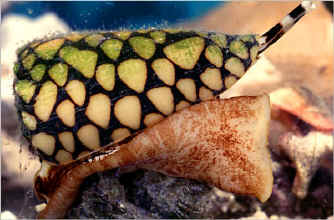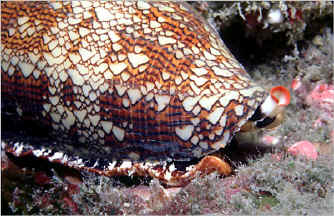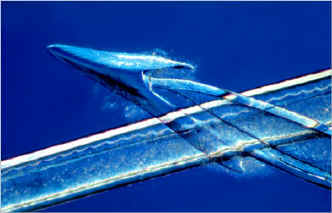|
A poison used by sea
snails to kill prey is being hailed as a painkiller a thousand
times stronger than morphine, writes Bruce Kemble.
Scientists discovered
that the cone snail, found on tropical reefs, shoots, a harpoon
carrying the venom at passing fish. The poison kills the fish
which the snail then reels in.
A team of American
researchers hopes to harness the poison's power and turn it into
a painkiller.
George Miljanich, a
neuroscientist and biochemist at the University of Southern California
who works for the Neurex corporation, is heading the team trying
to convert the snail's poison into a painkilling drug.
He says: "This
is a major breakthrough in the treatment of pain. We call it Ziconotide
and it doesn't have any side effects at all as far as we know."
"Cone-snail venom
is very effective at paralysing fish by acting on the nervous
system. As it blocks a fish's nervous system so well, we thought
it might be effective in blocking the nervous system of humans."
He thought that harvesting
the venom of millions of snails was impractical so he decided
to identify the ingredients of the poison. He had to establish
its molecular structure and find a way to copy it. "We discovered
it is a calcium blocker and it blocks communications from one
nerve cell to another," he says.
|
Signals from a growth
or an injury are normally transmitted to the brain where they
are perceived as pain. Ziconotide blocks these signals' routes
to the brain, leaving the rest of the nervous system working normally
and stopping the pain message getting through.
The Elan corporation,
the company marketing Ziconotide, is applying to the US Food and
Drug Administration for a licence to allow the new painkiller
to be approved for public use.
Robert Presley, a doctor
who has been testing Ziconotide at San Jose, California, says:
"Our rate of success has been 90%. We have used it on patients
with the most difficult, intractable problems. Nine out of 10
get at least partial relief."
Presley has tried Ziconotide
on more than 400 patients in severe pain and claims that it is
one of the most important drug developments in years.
He says: "This
is really the first compound to become available that is completely
different from morphine and its other opium cousins, yet more
potent than them.
"Things like aspirin
help for small things, but if you've got cancer all over your
body aspirin is not going to do much for you. If you don't respond
to morphine, there's really nothing else.
"At present, morphine
is the gold-standard pain medication. However, that's not going
to be the case for very long: Ziconotide will take over."
|

Conus marmoreus, The Marbled
Cone

Conus textile - Cloth
of Gold Cone

Harpoon From the Omaria Cone
|




